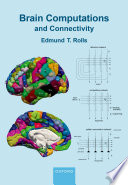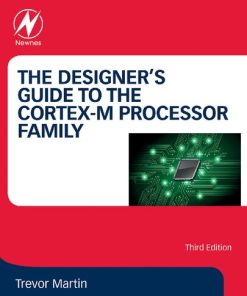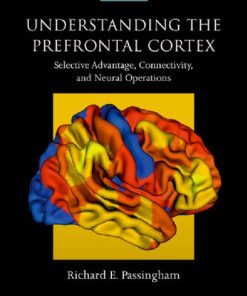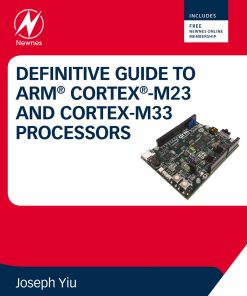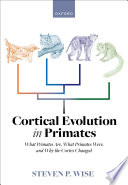(EBOOK PDF)The Orbitofrontal Cortex 1st edition by Edmund Rolls 9780192584823 0192584820 full chapters
$50.00 Original price was: $50.00.$25.00Current price is: $25.00.
The Orbitofrontal Cortex 1st edition by Edmund Rolls – Ebook PDF Instant Download/Delivery: 9780192584823, 0192584820
Full download The Orbitofrontal Cortex 1st edition after payment

Product details:
• ISBN 10:0192584820
• ISBN 13:9780192584823
• Author:Edmund Rolls
The Orbitofrontal Cortex
‘The Orbitofrontal Cortex’ explores a part of the brain that is important in human emotion, pleasure, decision-making, valuation, and personality. In ten chapters the book describes: · The OFC’s connections; · Its neuron level neurophysiology which is essential for understanding what information is represented in the orbitofrontal cortex; · Functional neuroimaging of the orbitofrontal cortex; · How it relates to the previous and succeeding areas in brain processing; · The effects of damage to the orbitofrontal cortex which provides important evidence about its functions; · How the orbitofrontal cortex is involved in psychiatric disorders including depression, bipolar disorder, and autism; · How and what the orbitofrontal cortex computes; · Future directions in understanding the functions of the orbitofrontal cortex in health and disease. The book is unique in providing a coherent multidisciplinary approach to understanding the functions of one of the most interesting regions of the human brain, in both health and in disease, including depression. The Orbitofrontal Cortex will be valuable for those in the fields of neuroscience, neurology, psychology, psychiatry, biology, animal behaviour, economics, and philosophy, from the undergraduate level upwards.
The Orbitofrontal Cortex 1st Table of contents:
1. Introduction to the orbitofrontal cortex
1.1 Introduction
1.2 The importance of understanding the primate, including human, brain
1.3 Functional neuroimaging in humans, neuronal encoding, and understanding the brain computationally
1.4 The orbitofrontal cortex: the plan of the book
2. Orbitofrontal cortex: anatomy and connections
2.1 Connections
2.2 Output pathways from the orbitofrontal cortex to the dopamine and serotonin brainstem systems
3. Orbitofrontal cortex processing: neurophysiology and neuroimaging
3.1 An overall framework for the role of the orbitofrontal cortex in the processing of reward in the brain
3.2 Taste and oral texture: outcome value
3.3 An olfactory representation in the orbitofrontal cortex of expected value
3.4 Convergence of taste and olfactory inputs in the orbitofrontal cortex: the representation of flavour
3.5 Somatosensory and temperature inputs to the orbitofrontal cortex, and affective value
3.6 Visual inputs to the orbitofrontal cortex, and visual stimulus–reinforcer association learning and reversal to compute expected value
3.7 Monetary reward value, and many other types of reward, are represented in the orbitofrontal cortex
3.8 Negative reward prediction error neurons in the orbitofrontal cortex, and visual stimulus–reinforcer association learning and reversal
3.9 Cognitive influences on the orbitofrontal cortex
3.10 Attentional modulation of affective vs sensory processing
3.11 The topology of the functional neuroimaging activations in the orbitofrontal cortex
3.12 Value representations in the orbitofrontal cortex and neuroeconomic decision-making
3.13 Decision-making mechanisms in the orbitofrontal cortex and elsewhere in the brain
3.14 A representation of novel visual stimuli, and memory-related effects, in the orbitofrontal cortex
3.15 Deep brain stimulation of the orbitofrontal cortex
3.16 The orbitofrontal cortex and addiction
4. Orbitofrontal cortex damage effects in humans and other primates
4.1 Non-human primates
4.2 Humans
5. Orbitofrontal cortex output pathways: cingulate cortex, basal ganglia, and dopamine
5.1 The cingulate cortex
5.2 Dopamine systems in the brain and reward prediction errors
5.3 The basal ganglia as an output system for emotional and motivational behaviour
6. The orbitofrontal cortex and emotion
6.1 An introduction to emotion
6.2 Rewards and punishers, and learning about rewards and punishers: instrumental learning and stimulus–reinforcer association learning
6.3 Individual differences in emotion, personality, and the orbitofrontal cortex
6.4 Emotional orbitofrontal vs rational routes to action
6.5 Comparison between the functions of the orbitofrontal cortex and amygdala in emotion
7. The orbitofrontal cortex, depression, and other mental disorders
7.1 Depression
7.2 A non-reward attractor theory of depression
7.3 Evidence consistent with the non-reward attractor theory of depression
7.4 Advances in understanding the functions of the orbitofrontal cortex in depression
7.5 Possible subtypes of depression
7.6 Implications for treatments for depression
7.7 Pharmacological treatments for depression
7.8 Mania and bipolar disorder
7.9 Autism
7.10 Attention-deficit / hyperactivity disorder
7.11 Compulsivity
8. The rodent orbitofrontal cortex
8.1 Evolutionary trends
8.2 Divisions and functions of the rodent orbitofrontal cortex
8.3 Neuronal activity in the rodent orbitofrontal cortex
8.4 A state space representation in the rodent orbitofrontal cortex?
8.5 Synthesis
9. Orbitofrontal cortex computations in a systems-level perspective
9.1 Pattern association memory
9.2 Autoassociation or attractor memory
9.3 An integrate-and-fire implementation of an attractor network for decision-making
9.4 A neurophysiological and computational basis for stimulus–reinforcer association learning and reversal in the orbitofrontal cortex
9.5 A theory and model of non-reward neural mechanisms in the orbitofrontal cortex
10. Synthesis: the Roles of the Orbitofrontal Cortex
10.1 Synthesis
10.2 The orbitofrontal cortex: future directions
Appendix 1: Glossary
A.1 General
A.2 Learning theory terms
References
Index
People also search for The Orbitofrontal Cortex 1st:
the orbitofrontal cortex edmund rolls
the orbitofrontal cortex
what is the orbitofrontal cortex responsible for
the orbits of the eyes are formed by
orbitofrontal cortex role
Tags:
The Orbitofrontal,Cortex Edmund Rolls,Edmund Rolls
You may also like…
Politics & Philosophy - Anthropology
Edmund Burke and the British Empire in the West Indies: Wealth, Power, and Slavery P. J. Marshall
Biology and other natural sciences - Human Biology
Brain Computations and Connectivity Edmund T. Rolls 2nd edition
Technique - Electronics: Microprocessor Technology
The Designer’s Guide to the Cortex-M Processor Family 3rd Edition
Medicine - Neuroscience
Computers - Programming
Definitive Guide to Arm Cortex-M23 and Cortex-M33 Processors 1st edition
Poetry - American Poetry
Fictions of the Press in Nineteenth-Century France 1st Edition Edmund Birch
Biology and other natural sciences - Biology




